-
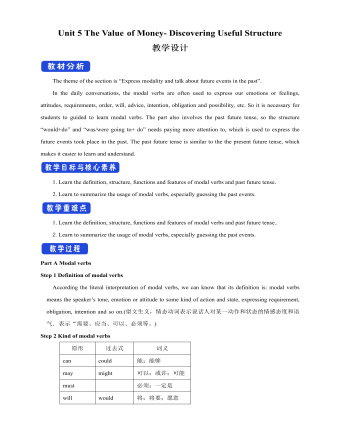
新人教版高中英语必修3Unit 5 The Value of Money- Discovering Useful Structure教学设计
Step 3 Meaning1. 过去将来时表示从过去某一时间来看将要发生的动作或存在的状态, 常用在宾语从句中。一般由“would/should +动词原形”构成。She hoped that they would meet again someday. 她希望将来有一天他们能再见面。2. was/were going to+动词原形: 表示过去将要发生或很有可能发生的动作, 常用于口语中, 表示预言、意图或者打算等。He was going to start work the following week. 他打算下星期开始工作。3. was/were about to do: 常用来表示即将发生的动作, “刚要/正要做……”。注意该结构不与任何时间状语连用。I felt that something terrible was about to happen. 我感到某种可怕的事情即将发生。4.was/were to do: 表示“曾计划做某事”, 如果表示“本来计划做某事, 动作没实现”, 则需用 “was/were to have done”。She said she was to have told me about the accident. 她说她本来想告诉我关于事故的事。5.Start, go, come, leave, see, meet等动词的过去进行时: 表示就过去某一时刻而言即将发生的动作。She was coming later. 她随后就来。I had just put on my overcoat and was leaving to visit a friend of mine. 我刚穿上外套要去看我的一个朋友。
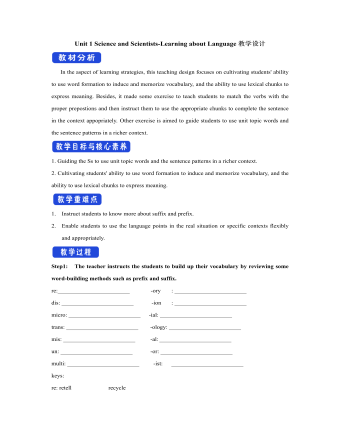
新人教版高中英语选修2Unit 1 Science and Scientists-Learning about Language教学设计
Step 7: complete the discourse according to the grammar rules.Cholera used to be one of the most 1.__________ (fear) diseases in the world. In the early 19th century, _2_________ an outbreak of cholera hit Europe, millions of people died. But neither its cause, 3__________ its cure was understood. A British doctor, John Snow, wanted to solve the problem and he knew that cholera would not be controlled _4_________ its cause was found. In general, there were two contradictory theories 5 __________ explained how cholera spread. The first suggested that bad air caused the disease. The second was that cholera was caused by an _6_________(infect) from germs in food or water. John Snow thought that the second theory was correct but he needed proof. So when another outbreak of cholera hit London in 1854, he began to investigate. Later, with all the evidence he _7_________ (gather), John Snow was able to announce that the pump water carried cholera germs. Therefore, he had the handle of the pump _8_________ (remove) so that it couldn't be used. Through his intervention,the disease was stopped in its tracks. What is more, John Snow found that some companies sold water from the River Thames that __9__________________ (pollute) by raw waste. The people who drank this water were much more likely _10_________ (get) cholera than those who drank pure or boiled water. Through John Snow's efforts, the _11_________ (threaten) of cholera around the world saw a substantial increase. Keys: 1.feared 2.when 3. nor 4.unless 5.that/which 6.infection 7.had gathered 8.removed 9.was polluted 10.to get 11. threat
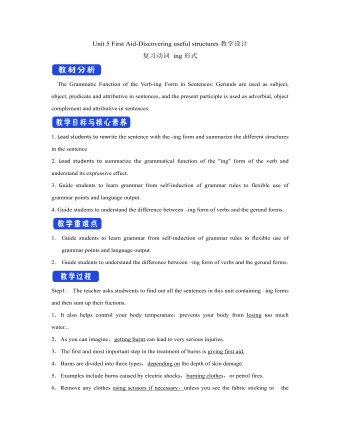
新人教版高中英语选修2Unit 5 First Aid-Discovering useful structures教学设计
You have no excuse for not going.你没有理由不去。He was punished for not having finished his homework.他因未完成作业而受到惩罚。2.动词ing形式复合结构由物主代词或人称代词宾格、名词所有格或普通格加动词ing,即“sb./sb.'s+doing”构成。动词ing形式的复合结构实际上是给动词ing形式加了一个逻辑主语。动词ing形式的复合结构有四种形式:①形容词性物主代词+动词ing②名词所有格+动词ing③代词宾格+动词ing④名词+动词ingHer coming to help encouraged all of us.她来帮忙鼓舞了我们所有人。The baby was made awake by the door suddenly shutting.这个婴儿被突然的关门声吵醒了。Can you imagine him/Jack cooking at home?你能想象他/杰克在家做饭的样子吗?无生命名词无论是作主语还是作宾语都不能用第②种形式。Tom's winning first prize last year impressed me a lot.汤姆去年得了一等奖使我印象深刻。Do you mind my/me/Jack's/Jack leaving now?你介意我/杰克现在离开吗?Excuse me for my not coming on time.很抱歉我没能按时来。His father's being ill made him worried.他父亲病了,他很担心。We are looking forward to the singer's/the singer to give us a concert.我们盼望着这位歌手来给我们举办一场演唱会。
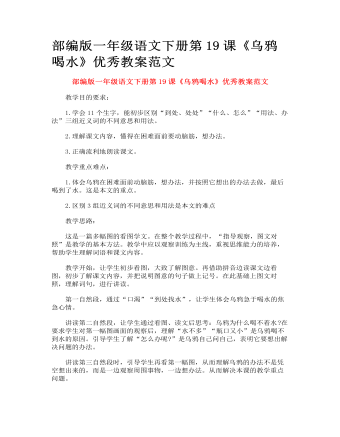
部编版一年级语文下册第19课《乌鸦喝水》优秀教案范文
教学思路: 这是一篇多幅图的看图学文。在整个教学过程中,“指导观察,图文对照”是教学的基本方法。教学中应以观察训练为主线,重视思维能力的培养,帮助学生理解词语和课文内容。 教学开始,让学生初步看图,大致了解图意。再借助拼音边读课文边看图,初步了解课文内容,并把说明图意的句子做上记号。在此基础上图文对照,理解词句,进行讲读。 第一自然段,通过“口渴”“到处找水”,让学生体会乌鸦急于喝水的焦急心情。 讲读第二自然段,让学生通过看图、读文后思考:乌鸦为什么喝不着水?在要求学生对第一幅图画面的观察后,理解“水不多”“瓶口又小”是乌鸦喝不到水的原因。引导学生了解“怎么办呢?”是乌鸦自己问自己,表明它要想出解决问题的办法。 讲读第三自然段时,引导学生再看第一幅图,从而理解乌鸦的办法不是凭空想出来的,而是一边观察周围事物,一边想办法。从而解决本课的教学重点问题。
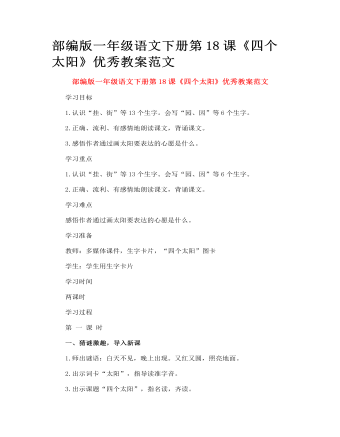
部编版一年级语文下册第18课《四个太阳》优秀教案范文
猜谜激趣,导入新课 1.师出谜语:白天不见,晚上出现。又红又圆,照亮地面。 2.出示词卡“太阳”,指导读准字音。 3.出示课题“四个太阳”,指名读,齐读。 4.引导质疑:读了课题,你的小脑瓜里是不是蹦出了小问号? 二、初读课文,认记生字 1.出示课件:带拼音生字,指名带读。 2.出示课件:去拼音生字并打乱顺序,摆字卡,自由练习朗读。 3.游戏:我说你找喊名字。 4.指导识记生字方法。 5.巩固游戏:我把生字送回家。动画演示,指导写字 1.猜谜引入:大口框里有个“大” 2.出示课件:“因”书写笔顺规则 看了动画,你知道了什么? 3.出示课件:“园” “园”与“因”哪里长得很像?书写的时候要注意些什么?(同样先里面后封口) 4.师范写“园”“因”,讲解书写要领。 5.生自由练写,师巡回指导。 6.集体评价。
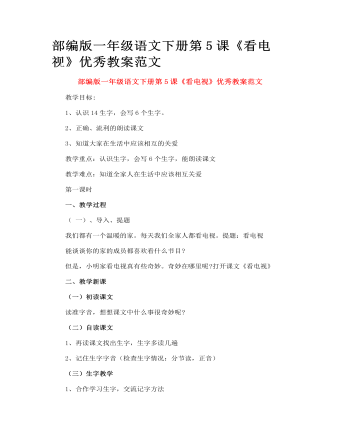
部编版一年级语文下册第5课《看电视》优秀教案范文
教学新课 (一)初读课文 读准字音,想想课文中什么事很奇妙呢? (二)自读课文 1、再读课文找出生字,生字多读几遍 2、记住生字字音(检查生字情况:分节读,正音) (三)生字教学 1、合作学习生字,交流记字方法 2、出示词语巩固生字 (四)写字教学 “全家”两字教学 (五)读懂课文 1、 再读课文,读懂后让你上来排顺序 爸爸和我———足球迷 奶奶———京剧 听的入迷 打盹睡觉 爸爸和我———足球 乐的直叫 一起拍手欢 妈妈 ———音乐 舞蹈 2、 找出把足球赛转成京剧的小节? 爸爸再看球赛时想到了什么? 3、 结果奶奶听的入迷,我和爸爸都在打盹睡觉。 奶奶又怎么想了呢? 找出京剧换成足球这一节?
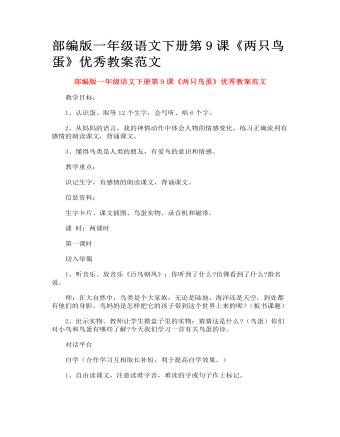
部编版一年级语文下册第9课《两只鸟蛋》优秀教案范文
朗读(读说思议练结合,培养学生语文综合能力。) 1、学习第一小节: (1)指名读,回忆刚才摸鸟蛋的感觉(小小的、凉凉的)体会着读一读。 (2)比较“鸟蛋凉凉的”和“凉凉的鸟蛋”:你发现了什么?(引导学生发现这类词语的特点:词序不同,但表达的意思相同。)除了凉凉的鸟蛋还有什么是凉凉的? (3)你还能像这样再说几个吗? (如果学生说不出来,教师可进行指导,把写有“花儿、小草、柳枝、大海,红红的、绿绿的、软软的、蓝蓝的”的词语卡分给学生,让拥有不同词语的学生去找朋友,再让两个朋友变换左右顺序。) 2、学习第二小节: (1)轻声读文,思考:你怎么知道两只鸟蛋就是两只小鸟? (2)出示小鸟破壳的图片或课件,引导学生说一说。 (3)启发想象:鸟妈妈焦急不安是什么样?你能表演一下吗? 表演后试着把妈妈的语气读出来。 (4)你还能用焦急不安说句话吗?看谁说得和别人不一样?
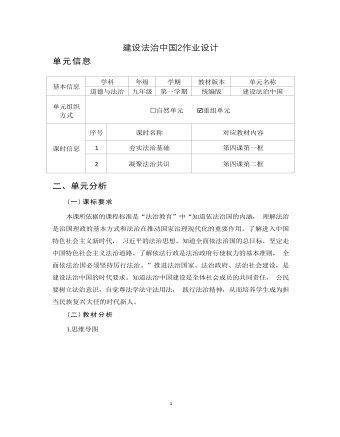
九年级上册道德与法治建设法治中国2作业设计
6.新冠肺炎疫情发生以来,中央强调,在疫情防控工作中,要坚决反对形式主义、 官僚主义, 让基层干部把更多精力投入到疫情防控第一线。这样要求 ( )①有利于政府工作人员依法行政②有利于政府履行职责,维护广大人民群众的根本利益③有利于形成良好的社会风气④警示人类必须坚持走可持续发展的道路A. ①②③ B. ①②④ C. ①③④ D. ②③④ 7.中央纪委监察部网站(现中央纪委国家监委网站)开通纠正“四风”(形式主义、 官僚主义、 享乐主义和奢靡之风) 监督举报直通车,引导网友积极举报各种公款 吃喝、公款旅游等“四风”问题。这一做法 ( )①扩大了我国公民的政治经济权利②有利于政府依法行政,实现国家长治久安③有利于提高我国公民的民主监督意识④有利于国家机关及其工作人员勤政廉洁A. ①②③ B. ①②④ C. ①③④ D. ②③④ 8.《孟子 ·离娄上》有言:“徒善不足以为政, 徒法不能以自行。”
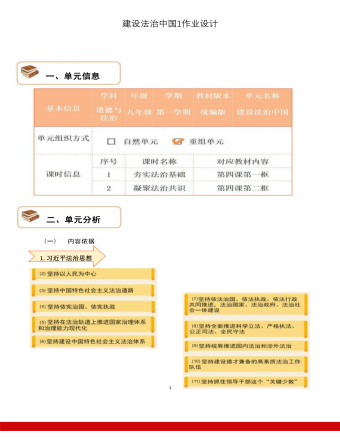
九年级上册道德与法治建设法治中国1作业设计
3.“法治素养”是现代公民应该具备的核心素养。下面是小法家近期的行为表现,其中体现“法治素养”的有 ( )①在2022年“两会”期间,小法爸爸积极宣传国家的法律法规②小法将看到的不文明行为拍成微视频,未加处理就分享到朋友圈③市政府公开征集2022年民生建设项目,小法和家人讨论后,提出家庭意见④发现刚买的运动鞋有质量问题,小法和妈妈一起拿购物凭证与商家协商解决 A.①②③ B.①②④ C.①③④ D.②③④4.开学以来,小法所在的学校以“全民守法,中学生在行动”为主题开展了模拟法庭、 法治情景剧等活动,这些活动加深了学生对法律知识的理解。以下哪一项是中学生能够做到的 ( )A.使每部法律法规都得到严格执行 B.认真学法、 自觉守法、依法维权C.法定职责必须为,法无授权不可为 D.主动调解民事纠纷,维护公平正义5. 下面是小法同学在道德与法治课堂上的一段分享,从中可以看出 ( )我的分享:在《中华人民共和国未成年人保护法 (修订草案) 》向社会征求意见时,我 们通过调研, 以 自己的视角和方式提出修改意见,其中有一条修改意见被采纳, 还收到了全国人大常委会法制工作委员会的感谢信,我们既兴奋又自豪。
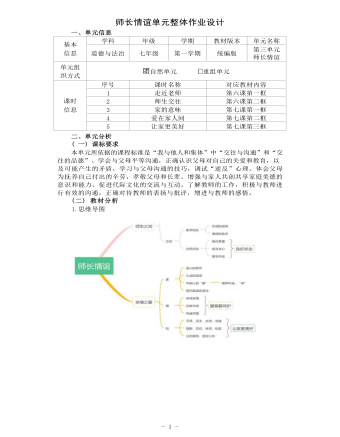
初中道德与法治七年级上册师长情谊作业设计
(2) 请你结合上述两幅漫画,对这一行为进行简要评析。15.某校七年级组织学生以“孝亲敬长”为主题开展手抄报评比活动。下面是某 同学手抄报的部分内容,请你阅读并参与完成相关问题。[我的感受]在人世间,最美的旅行是回家。无论走得多远,每个游子的心里也都有一个 归家的梦!回家的感觉真好!(1) 结合所学的知识,分析说明“回家真好”的原因是什么?[我的思考]调查显示:在当今家庭中,许多孩子不要父母过多干涉他们的学习和生活, 很多同龄人有被父母偷看过 QQ、微信聊天记录和日记的经历……(2) 针对调查显示的问题,你认为应怎样做才能处理好亲子之间的冲突?[我的鉴赏]人生最美好的事,莫过于我长大,你未老。我有能力报答,你仍然健康。父 母之爱,儿女即使用一辈子也是报答不完的。
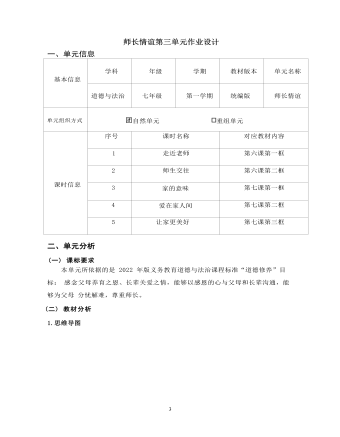
初中道德与法治七年级上册师长情谊5作业设计
2.内容内在逻辑本单元包括两课。 第六课设计了“走近老师”和“师生交往”两框内容。第一框通过 了解不同时期的老师,让学生从多层面、多角度认识老师这一职业群体;结合学生学 习实际,发现风格不同的老师,进一步引导学生学会接纳、尊重不同风格的老师,继 而建立对老师应有的正确“印象”;构建与老师良好交往的逻辑起点。第二框通过帮 助学生正确对待老师的引领与指导、表扬与批评以及与老师的矛盾与冲突,使学生认 识到亦师亦友的师生关系是师生交往的理想状态;并以实际行动与老师共建良好师生 关系,共度教育好时光。第七课设计了“家的意味” 、“爱在家人间”和“让家更美好”三框内容。第一框通过 引导学生联系已有的生活经验认识“家”是什么,结合对“家”及有关优秀的传统文化 进行探讨与分享,认识中国人的“家”是怎样的;在对“家”基本认知的前提下,第二 框进一步引导学生理解家的最本质内涵是“爱” ,并以实际行动去呵护“爱”;在对 “家”和“爱”的认知基础上,第三框进一步引导学生学会与家庭成员友好相处,从 而构建和谐的家庭关系,让家更美好。
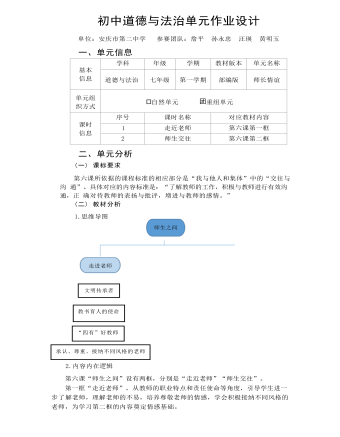
初中道德与法治七年级上册师长情谊13作业设计
一、单项选择题1.“一支粉笔两袖清风,三尺讲台四季晴雨;十卷诗赋九章勾股,八索文思七纬 地理。”这幅对联歌颂的对象是 ( )A.科学家 B.教师 C.医生 D.警察2.建校 12 年,云南丽江华坪女高 1000 多名女生走出大山上大学。她以怒放的生 命,向世界表达倔强,她就是崖畔桂雪中的梅。她就是 2020 年度感动中国人物 ——张桂梅。她之所以让我们感动,是因为她 ( )①有理想信念 ②有仁爱之心③有道德情操 ④有较高学历A.①②③ B.①②④C.①③④ D.②③④ 3.初中生丽丽觉得初中数学老师上课没有小学数学老师幽默,导致他现在对数学 不感兴趣,成绩直线下降。针对丽丽的的情况,同学们纷纷给出建议,你赞同的 是 ( )A.让老师改变教学风格B.要求调换一位教学风格幽默的老师C.每位老师风格不同,我们应尊重老师的“不同”
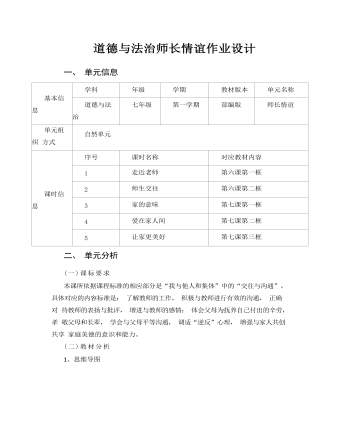
初中道德与法治七年级上册师长情谊7作业设计
2 、研读课标要求、分析教材内容,进一步明确目标、分析学情。3 、制定作业目标,确定作业形式及反馈方法、评价要求。4、分课时作业设计流程(1)根据任务分配, 各人完成课时作业设计。明确作业目标→ 明确训练方 向→选择作业素材、呈现方式→设定问题→确定时间→设定评价方式。5 、小组研讨,对作业设计初稿讨论、修改、定稿。五、分课时作业:6.1《走近老师》作业设计作业 1(一)作业内容“走近老师”这一框从教师的职业特点和责任使命等角度, 引导学生进一步 了解老师。理解老师的不易、培养尊敬老师的情感, 学会积极接纳不同风格的老 师。教学重难点是学会全面认识老师和学会接纳与欣赏不同的老师。我设计的作 业如下:活动:采访我的老师布置学生的采访任务, 每小组选择一位任课教师进行采访, 采访前确定采访 提纲:从教师工作内容、教师入职准备、教学困扰、兴趣爱好等方面设计提纲。 选择不打扰老师工作和休息的时候做采访,采访后应做总结或者感悟。
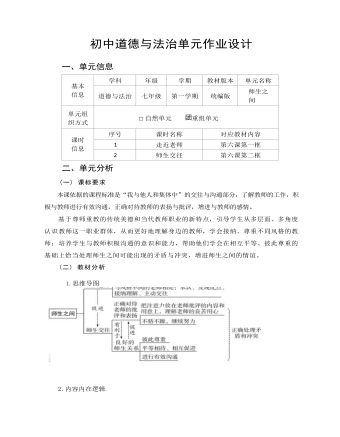
初中道德与法治七年级上册师生之间作业设计
第六课“师生之间”是七年级上册第三单元第一课。本课基于初中学生自我意识 增强、思维能力发展的特点,着力处理青春期的独立性与依赖性的矛盾,帮助学生深 入认识和理解自己的老师。在感受老师对自己的关爱和教育的同时,学会主动关心、 帮助老师,与老师建立一种良好的师生关系。本课与第七课“亲情之爱”内容继承了 孝亲敬长的中华传统美德,落实了社会主义核心价值观的基本内容,指引学生正确处 理师生关系、亲子关系和家庭关系,是初中学生人际交往的拓展与延伸。第一框“走近老师”,从教师的职业特点和责任使命等角度,引导学生进一步了解 老师,理解老师的不易,培养尊敬老师的情感,学会积极接纳不同风格的老师,为学 习第二框的内容奠定情感基础。第二框“师生交往”,引导学生懂得“教学相长”的道理,强调师生之间的双向互动,引导学生正确对待老师的引领和指导,全面认识师生交往的实质,努力建立和谐 的师生关系,达到师生交往理想而美好的状态。
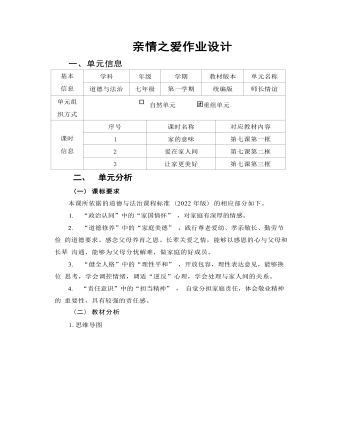
初中道德与法治七年级上册亲情之爱2作业设计
(一) 课标要求本课所依据的道德与法治课程标准 (2022 年版) 的相应部分如下。1. “政治认同”中的“家国情怀” ,对家庭有深厚的情感。2. “道德修养”中的“家庭美德” ,践行尊老爱幼、孝亲敬长、勤劳节俭 的道德要求。感念父母养育之恩、长辈关爱之情,能够以感恩的心与父母和长辈 沟通,能够为父母分忧解难,做家庭的好成员。3. “健全人格”中的“理性平和” ,开放包容,理性表达意见,能够换位 思考,学会调控情绪,调适“逆反”心理,学会处理与家人间的关系。4. “责任意识”中的“担当精神” , 自觉分担家庭责任,体会敬业精神的 重要性,具有较强的责任感。(二) 教材分析1.思维导图2. 内容内在逻辑第七课《亲情之爱》是七年级上册第三单元第二部分内容。在介绍与同学、 朋友、老师交往的基础上,要求学生认识、了解家庭,学会与家人交往。
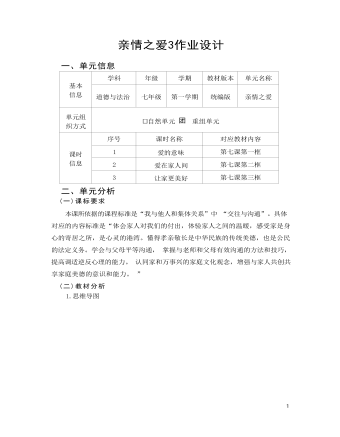
初中道德与法治七年级上册亲情之爱3作业设计
【答案】 (1) 反映了微信、 微博等现代沟通手段影响家庭成员之间的生活与 交流方式。一些子女随着年龄的增长反感父母的过度关注,故意设置障碍将父母 屏蔽,影响了与父母的沟通与交流。(2) ①在家庭中,家人之间有着不同的价值观念和生活方式,这些差异可能 带来家庭成员间的矛盾和冲突,影响家庭和谐。 ②这需要家庭成员之间互相信 任、体谅和包容。 ③有效的交流和沟通,可以增进理解,化解矛盾和冲突。 ④孝 亲敬长,要从小事做起,细致入微的关怀,要亲近父母,主动与父母进行沟通。【设计意图及分析】第 (1) 问考查与父母的交流问题,从微信、 微博等影响 家庭成员之间的交流方式,一些子女反感父母的过度关注,故意设置障碍将父母 屏蔽,影响了与父母的交流等角度作答。第 (2) 问考查建设和谐美好家庭的要 求,从家庭成员冲突的原因;化解冲突需要家庭成员之间互相信任、体谅和包 容;交流和沟通;孝亲敬长,要从小事做起,亲近父母,主动与父母交流;用良 好心态面对家庭发生的变化等角度作答。
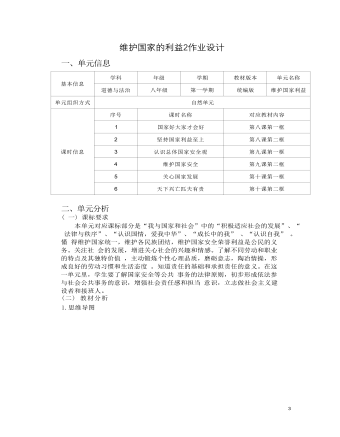
道德与法治八年级上册维护国家利益2作业设计
2. 内容内在逻辑第八课《国家利益至上》设计了“国家好,大家才会好”“坚持国家利益至 上”两框内容,其立意在于帮助学生认识维护国家利益的重要性,正确认识国家 利益与人民利益的关系,提高维护国家利益的意识,树立正确的国家利益管,提 高辨析各种爱国观念和行为的能力,使自己的爱国情感更加理性、深沉。第九课《树立总体国家安全观》设计了“认识总体国家安全观”和“维护国 家安全”两框。 目的在于引导学生正确理解和全面把握我国安全形势面临的挑战 ,从小树立总体国家安全观, 自觉担负起维护国家安全的责任。第十课《建设美好祖国》设计了“关心国家发展”“天下兴亡,匹夫有责” 两框内容,其目的和意图在于帮助学生全面认识国家发展,从初中学生的角度认 识祖国发展,正视国家发展过程中的问题,理解自己与国家发展的密切关联,让 学生在关心祖国发展的同时,为将来投身于国家建设奠定认识基础。

道德与法治八年级上册网络生活新空间作业设计
5. 当今世界,日新月异的互联网不仅促进了社会生产力的新变革,而且创造 了人类生活新空间。下列属于网络推动社会进步的表现的是( )① 网络让我们日常生活中的信息传递和交流变得方便迅捷② 网络为经济发展注入新的活力,推动传统产业转型升级③ 网络丰富民主形式,促进民主政治进步④ 网络为文化传播和科技创新搭建新平台A.①③④ B.②③④ C.①②④ D.①②③④二、非选择题?6. “互联网"让浙江农业有了别样面貌。信息经济在浙江腾飞, 赋予了这片土地上的农民格外活跃的互联网思维。他们开网店卖农产 品,红红火火。浙江的“互联网+”农业还远不止把农产品搬到网上。 越来越多的农民在土地上播撒下互联网种子,捕捞那跳跃的数字,用 它指导生产、提高亩产。互联网让农民有了不一样的面貌,更让现代 农业有了全新的模样。(1) 互联网对经济发展起到了怎样的促进作用?(2) 互联网的快速发展还在哪些方面产生了影响?

道德与法治八年级上册网络生活新空间2作业设计
8.2021年10月11日下午, 2021年国家网络安全宣传周网络安全技术高峰论坛在西安 国际会展中心举行。本届宣传周以“网络安全为人民,网络安全靠人民”为主题。为促 进网络安全,我们中学生可以( )①自觉遵守国家法律,规范自身行为 ②加强对互联网的监督管理③应增强尊法学法守法用法意识,强化规则意识 ④开展网上扫黄打非专项活动A.①③ B.①④ C.②③ D.②④9.2022年春天,受新冠肺炎疫情影响很多行业都处于“封冻期”,电商直播行业却 逆势上涨,成为逆势发展的一个新风口。但电商直播购物存在的人气造假、评论造假、 夸大宣传、诱导交易等问题也值得我们警惕。对此,你的看法是( )①电商直播新经济,推动发展当支持 ②遵法守信讲规则,电商直播当谨记③直播购物要理性,提高警惕重防范 ④电商购物易受骗,及时远离方为妙A.①②③ B.①②④ C.①③④ D.②③④
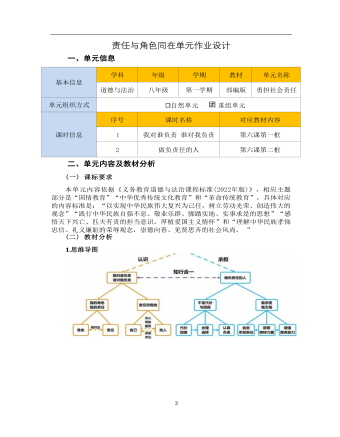
道德与法治八年级上册责任与角色同在作业设计
2.内容内在逻辑本单元《责任与角色同在》重点在责任意识的培养,为培养学生服务社会的 精神做好铺垫。第一框“我对谁负责 谁对我负责”,是从“认识责任”的角度厘清责任的 相关知识,包含责任的含义、责任的来源、责任与角色的关系,使学生明确自身 应承担的责任,理解承担责任对个人和社会的意义。第二框“做负责任的人”,是在第一框“认识责任”的基础之上,进一步探 讨“承担责任”。引导学生认识到承担责任意味着要付出一定的代价,也会获得 回报,要学会合理选择并对自己的选择负责。对于不是自愿选择但又必须做的事 要自觉承担、尽力做好,努力向履行社会责任却不计得失的人学习。综合来看,第一框主要帮助学生从思想上认清责任的来源以及责任与角色的 关系,明确责任是相互的。要成为负责任的人,关键还是要落实到行动中。第二 框则进一步引导学生从行动上提高责任意识, 主动承担责任。两框内容是有机统 一的。







